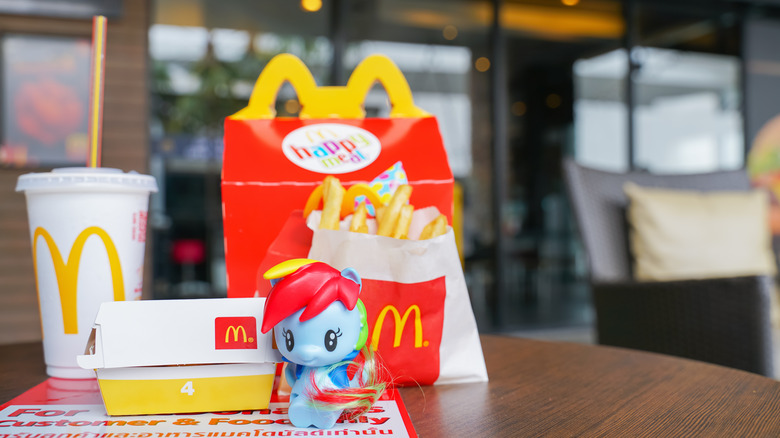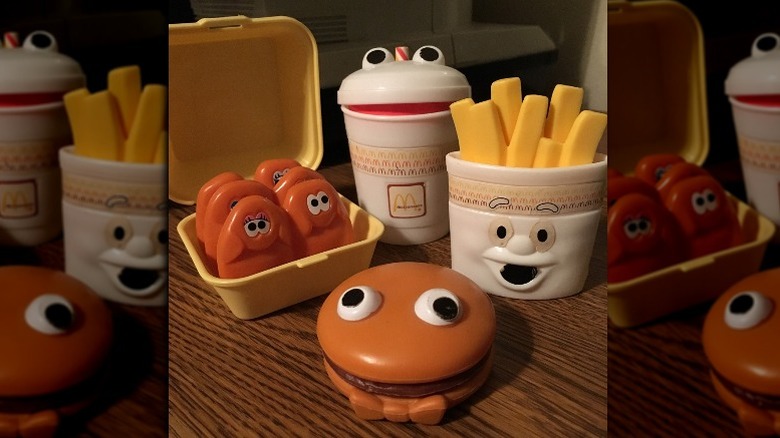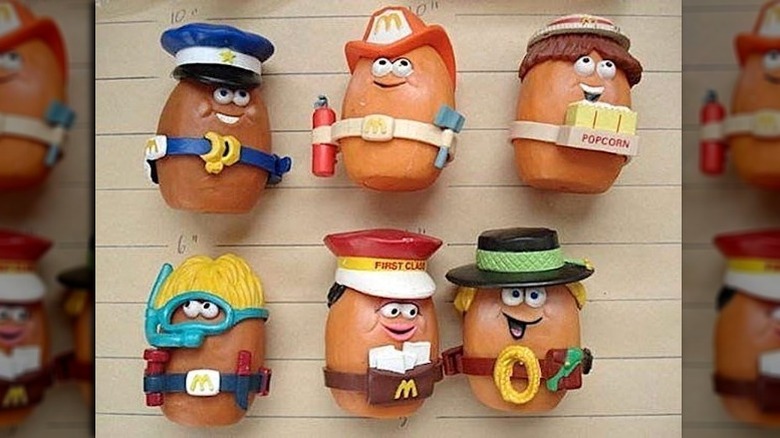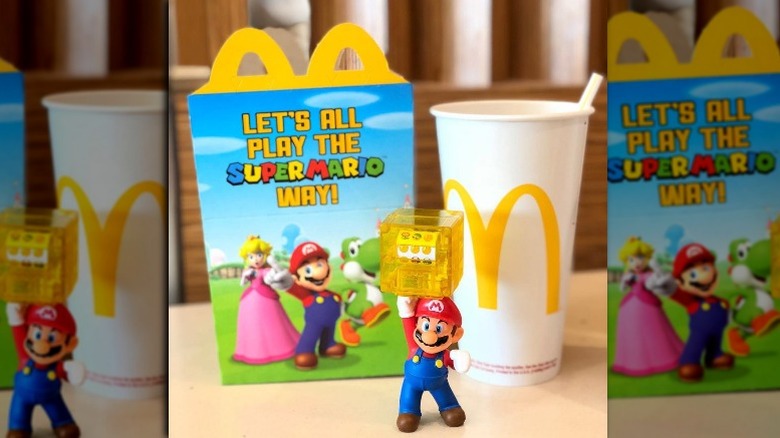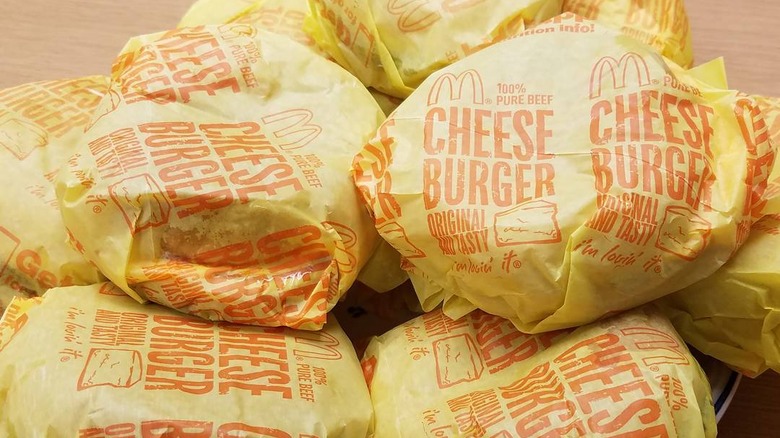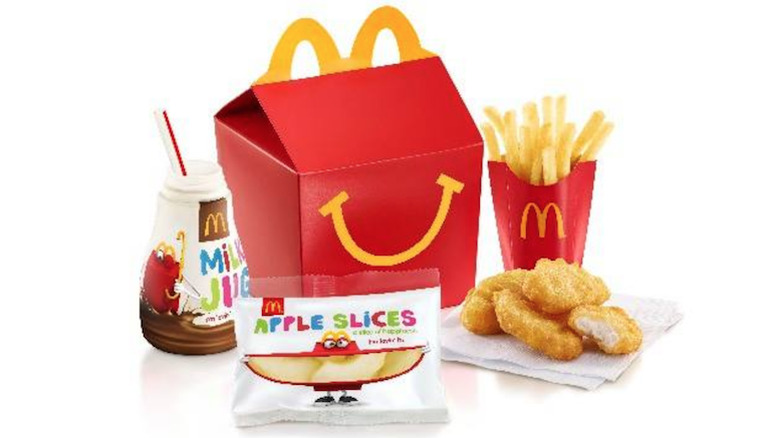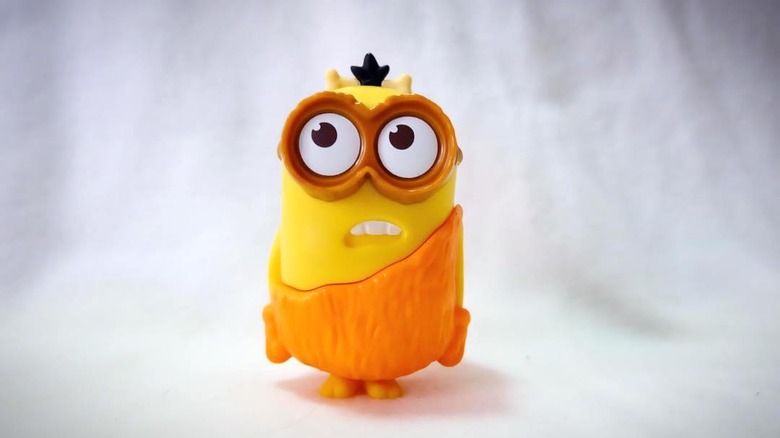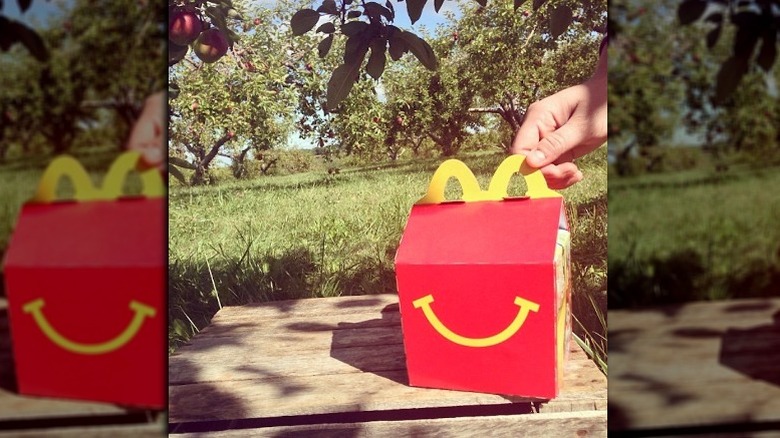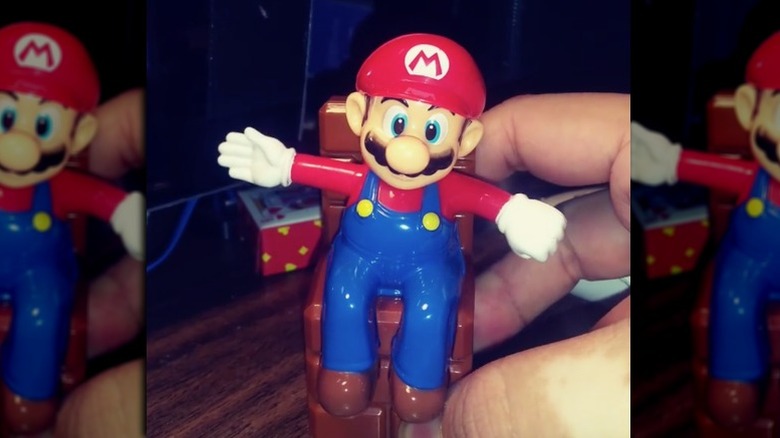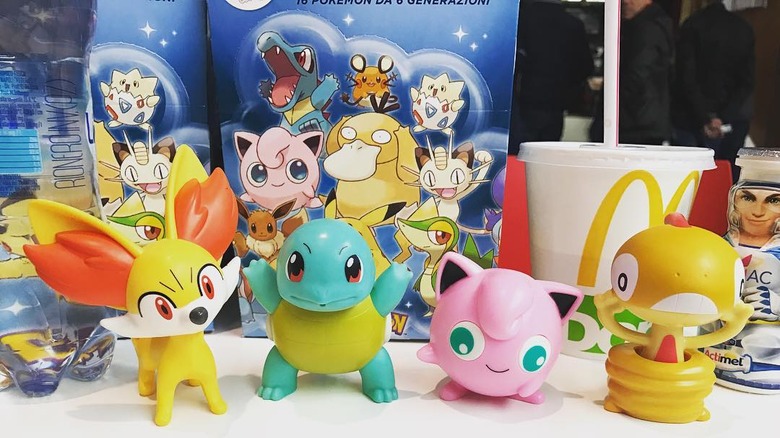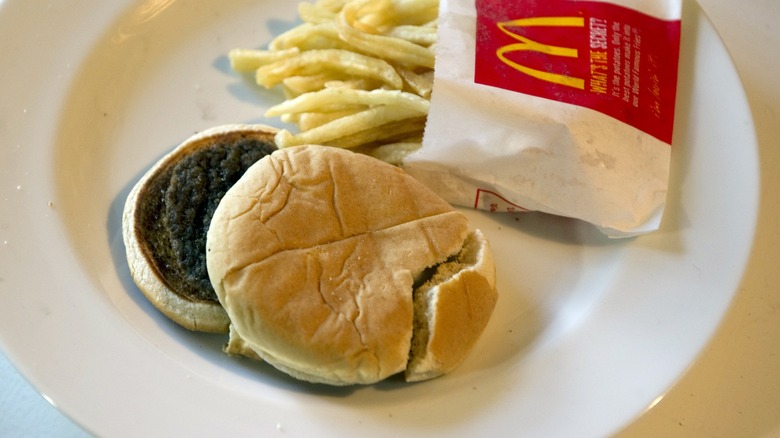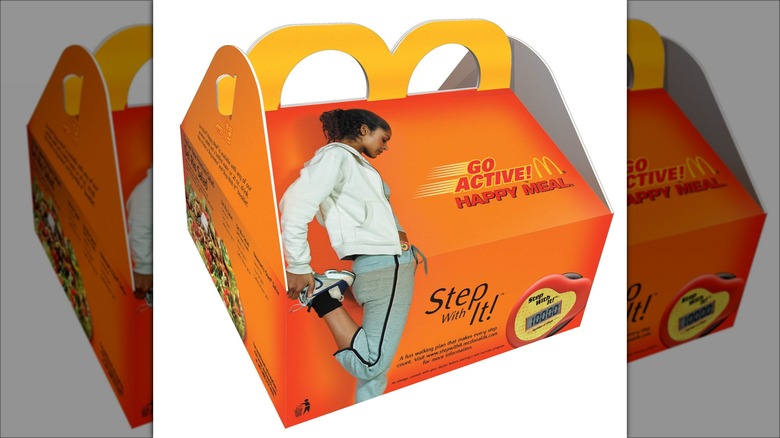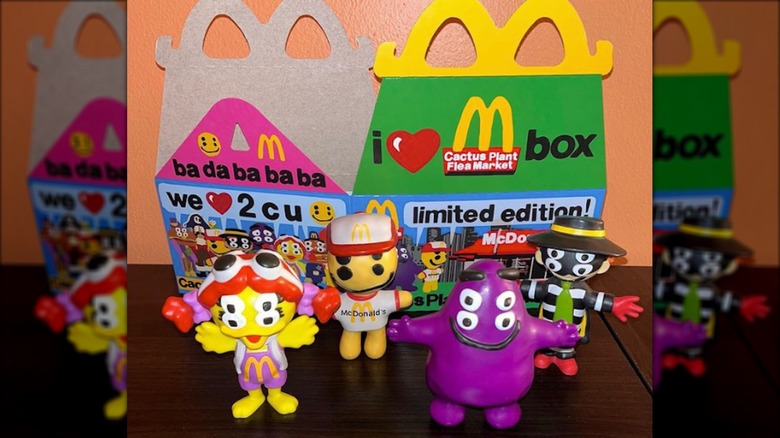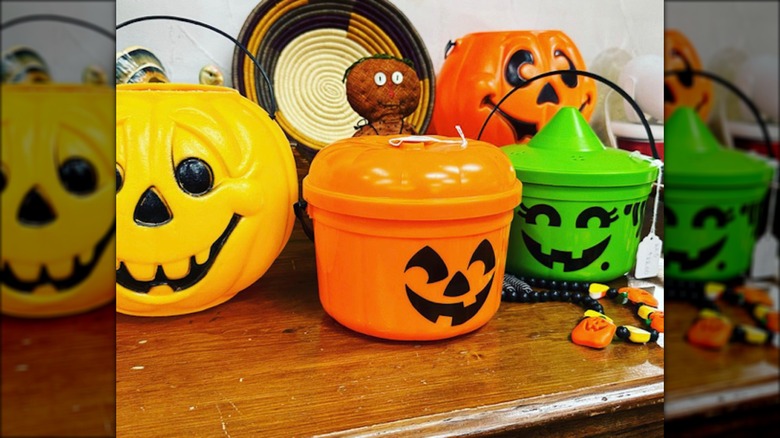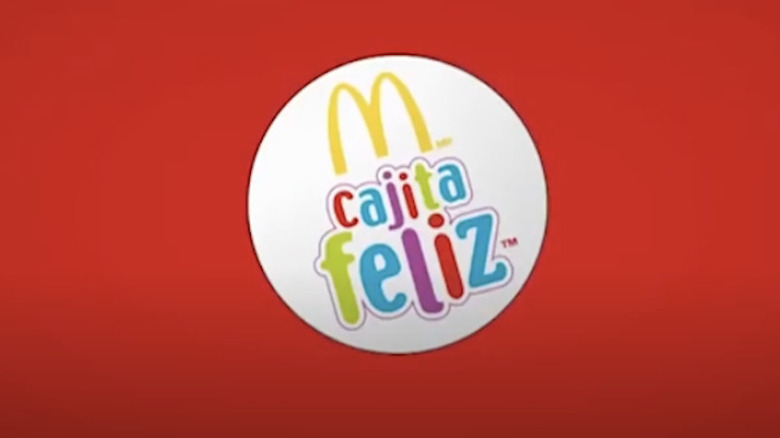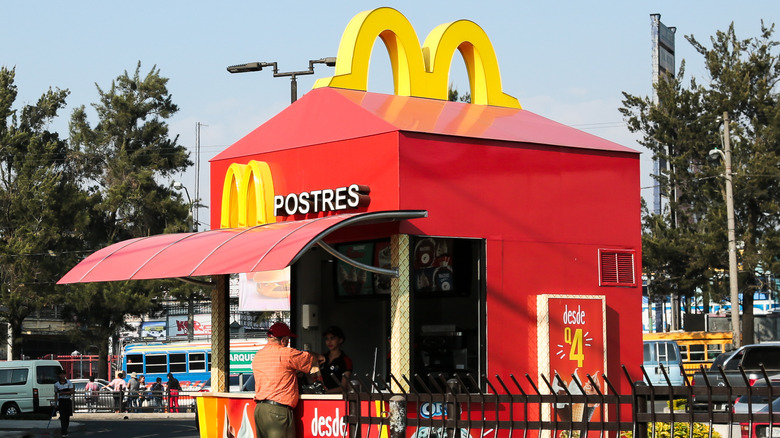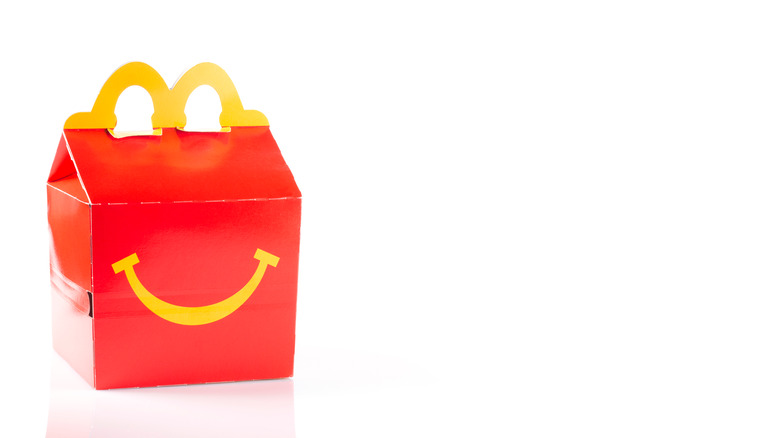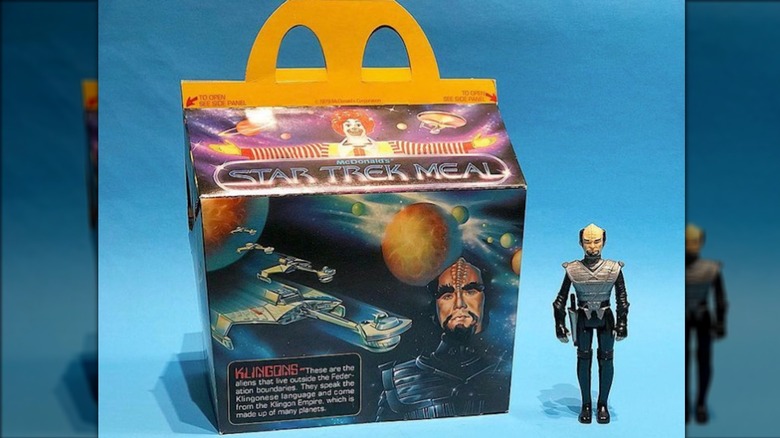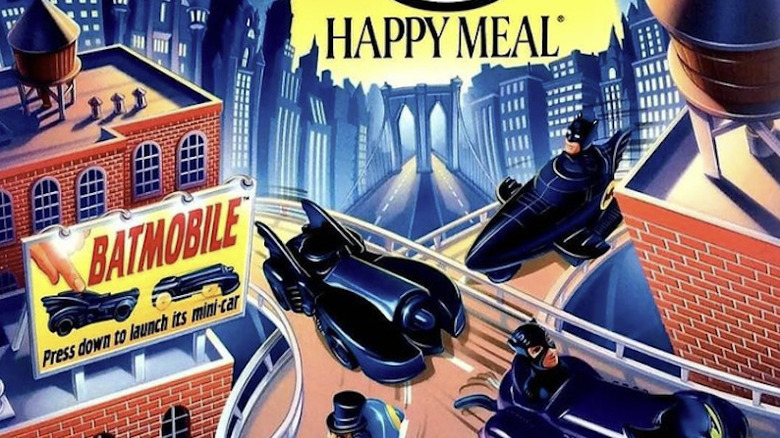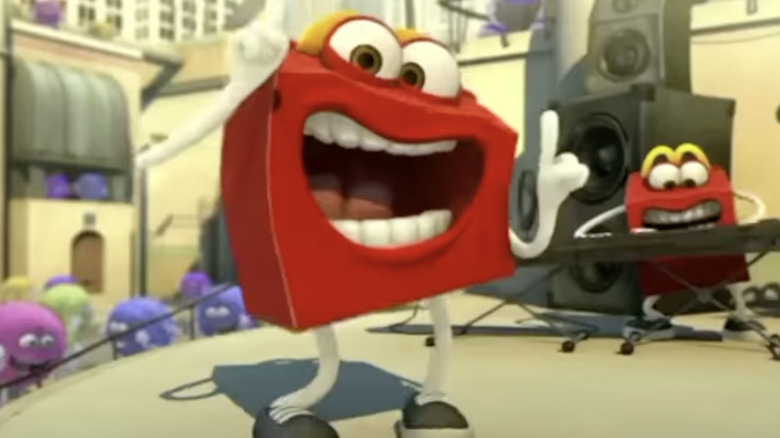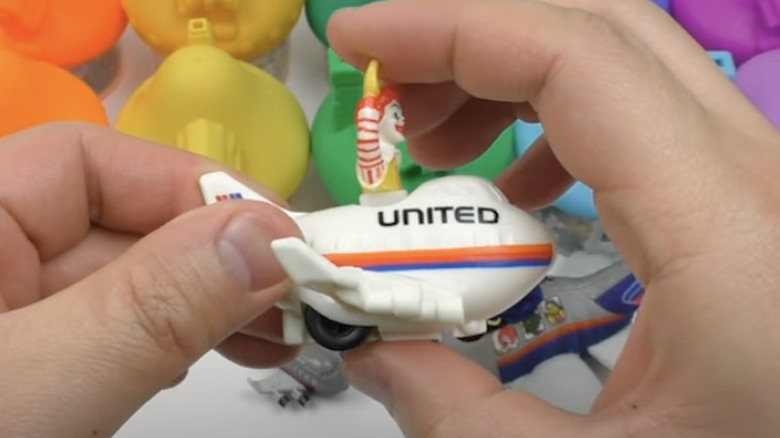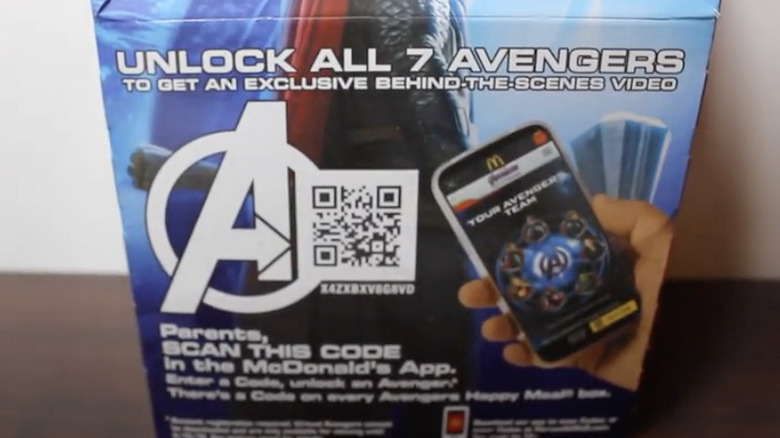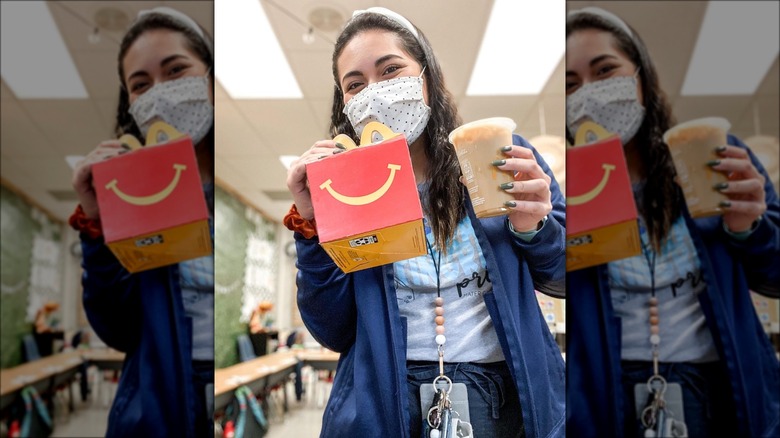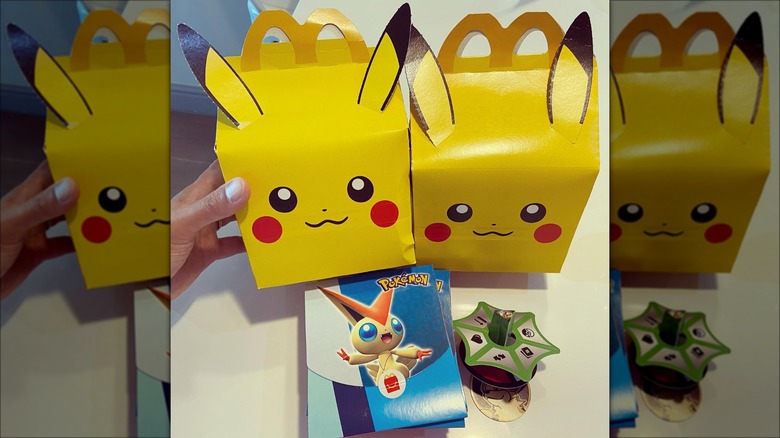Everything We Know About McDonald's Famous Happy Meal
Since 1979, McDonald's Happy Meals have been an integral part of most childhoods, and whether it's a once a week, once a month, or once a year treat, the excitement level for that iconic cardboard box is the same. Those perfectly salted fries and arguably plain but oh-so-tasty hamburger with just the right amount of rehydrated onion and pickle are the epitome of fast food deliciousness. But let's be honest — it's the toy that really matters when you're anxiously waiting in the backseat of the car.
As a kid, you didn't concern yourself with the history of the Happy Meal, or strange stories associated with it. So long as you could get your hands on that toy, what did you care? But adults might find it surprising that their little one's favorite meals have been used as a drug front, or that the apple slices take an unusually long time to turn brown. And did that Minion toy really say what we think it said? Let's dive into the untold truth of McDonald's famous Happy Meal.
Vintage toys can be worth a pretty penny
Most of us had that box of beat-up Happy Meal toys from our childhood that at some point in our teen years got put into the donation pile without a second thought. But if you'd kept that box, and if those toys had been in pristine condition and in the original packaging, they might be worth a pretty penny today.
In May 2018, LoveAntiques.com commissioned a toy expert to compile a list of "the most valuable McDonald's toys you may have at home," and the potential sales figures might surprise you. At the top of the list, coming in at $450, is a set of TY's Teenie Beanie Boos from 2000, which the site says is "much rarer than their toy shop equivalent." The oldest toys on the list, both from 1979 and going from $400 each, are a set of Underwater Monsters, and Robots by Diener Keshi. Not too shabby for a few pieces of plastic, right? On the flip side, if you somehow managed to track down all 101 toys from the 1996 101 Dalmatians collection, you'd only be looking at $220, and considering you probably spent more on the Happy Meals, that's not such a great return on investment.
But how much can you really get for them?
Now you're probably kicking yourself for tossing your Happy Meal toys all those years ago, but are those numbers even feasible in the real world? According to Today, who spoke to experts in toys and antiques, the likelihood of getting rich quick from vintage Mickey D's toys is not great, but of course there are always exceptions. Dov Kelemer, president of DKE Toys, explained, "Unfortunately, in my toy dealing experience most modern McDonald's Happy Meal toys have little or no value to collectors and I doubt there are any notable auction houses selling them."
Today reports that most toy listings on eBay are firmly in the under-$100 range, with an occasional jaw-dropping auction price popping up, like a complete set of 100 Years of Disney Magic toys for an astounding $10,000. "As with any collectibles category, the main factors of value are supply and demand, impacted often by a 'nostalgia curve'..." antiques appraiser Gary Sohmers noted. In other words, rare gems could fetch high dollars, but most likely won't.
San Francisco tried to ruin all the fun
San Francisco might be considered the West Coast's foodie paradise for adults, but in 2010 they voted to dash the dreams of all Happy Meal-loving kids when, according to Reuters, its Board of Supervisors passed a law requiring that "restaurant kids' meals meet certain nutritional standards before they could be sold with toys." The law, which went into effect in 2011, allowed toys to be given away provided that the meal "have less than 600 calories, contain fruits and vegetables, and include beverages without excessive fat or sugar."
McDonald's obviously opposed the law, saying in a statement, "We are extremely disappointed with today's decision. It's not what our customers want, nor is it something they asked for." Of course, the company quickly found a loophole for this new law without having to comply with all those pesky nutritional requirements: A 10 cent donation to the Ronald McDonald House (via Business Insider). By tacking an extra dime onto each Happy Meal purchase when a toy was included, they were able to satisfy their obligation to the law and benefit their charity at the same time.
The cheeseburger Happy Meal is a thing of the past
Since that 2011 San Francisco toy ban, McDonald's has made some positive changes to its famous Happy Meal. The option of apple slices (which actually began in 2004), gave parents the choice between french fries or fruit, but today, a regular Happy Meal bundle automatically includes the choice of apple slices, low-fat Yoplait Go-Gurt, or Cuties (when in season), and a smaller kid-sized fry. The soft drink option is also long gone, and now it's a choice between milk or apple juice. It was a good start...
But thanks to chocolate milk and cheeseburgers, the Happy Meal was still hitting above that 600 calorie mark. In an effort to finally get the numbers down, McDonald's removed the cheeseburger and chocolate milk Happy Meal options in June 2018, as per Today. The chocolate milk was slated to return later with reduced sugar. Currently, the highest calorie combination — six-piece Chicken McNuggets, fries, Go-Gurt, and 1% milk — comes in at 530 calories. Great news, right? Not for everyone. While you might think this healthy change would be celebrated all around, adult consumers took to social media lamenting the removal of the cheeseburger, dubbing it a #sadmeal. Proof that you can't win 'em all.
But why don't those apple slices turn brown?
Parents celebrated when McDonald's made the change to include apple slices in their Happy Meals, but alarms started going off when consumers realized that the fruit took an unusually long time to turn brown. So what's the deal?
A quick glance at the ingredient list for the apple slices will clue you in — along with the fruit you'll find calcium ascorbate, which according to McDonald's is "a blend of calcium and vitamin C to maintain freshness and color." But is calcium ascorbate some scary chemical we should be afraid of? Nope. According to the FDA, it's "generally recognized as safe when used in accordance with good manufacturing practice," and at the end of the day, actually makes those apple slices much more palatable than if not treated. This is because as soon as an apple is cut, oxygen starts to deteriorate its flesh and causes it to turn brown. Thanks to the calcium ascorbate dip (also called NatureSeal), the cut apple slices are protected from those changes in texture, color, and taste, and have an impressive 21-day shelf life.
WTF did that Minion say?
A Despicable Me Happy Meal toy caused an uproar when outraged grandparents alerted the media to a Minion, which was included in their grandchild's meal, that appeared to be spewing profanity (you can listen here). Indeed, to those of us with potty mouths, the toy does seem to be saying, "What the f***?"
McDonald's, however, denied the claims, and a spokesperson told MarketWatch that the loin cloth clad Minion toy included three recorded sounds: "Para la bukay," "hahaha," and "eh eh." Apparently "hahaha" in Minionese sounds an awful lot like "WTF?" in English. "We're aware of a very small number of customers who have been in touch regarding this toy, and we regret any confusion or offense to those who may have misinterpreted its sounds. The allegation that this toy is saying anything offensive or profane is not true," the company said. McDonald's did not pull the toy over the controversy, and there's no telling how many kids picked up a useful new phrase.
A Happy Meal with a side of heroin
Imagine if you rolled through the McDonald's drive-thru for a special surprise for your kids and ended up with a Happy Meal full of heroin. Sounds unbelievable, but that's exactly what you would have gotten at one Pittsburgh location if you said the magic words: "I'd like to order a toy." Since a toy can legitimately be purchased separately from a Happy Meal (in some regions), the request wouldn't have seemed too out of the ordinary for those in the know, but in this case that "toy" was actually heroin, as per CNN.
McDonald's employee Shantia Dennis was arrested in 2014 after she was busted by undercover police officers for, among other charges, possession with intent to deliver heroin. After receiving a tip from an informant, the officers ordered a "toy" in Dennis' drive-thru, paid her $80 for what should have been about a $2 bill, and got a Happy Meal box full of 10 small bags of heroin. No word on whether the order also included the usual hamburger and fries, but if it did, it was a real "value meal."
What exactly is Mario doing?
Over the years McDonald's has featured several Super Mario collections, and some of those toys have struck consumers as a bit odd.
In 2017, a collection that debuted in the UK prompted punny headlines like, "Super Mario McDonald's UK Happy Meal Toys Revealed, Evidently Much to Mario's Relief." See, Mario is supposedly sitting on a pile of bricks, but if you use your imagination, you can easily see Nintendo's favorite plumber copping a squat on the toilet. EuroGamer.net reported that commenters had a field day with the revelation, with one user remarking, "So that's where the phrase 'sh***ing bricks' comes from!" Cue the rimshot.
In another incident, tabloid website The Mirror reported on a toy that "looks like it's performing a sex act." This particular Mario had a mechanical arm with a boomerang in his hand, but when the boomerang was removed, the hand was left with a hole in the middle. Couple that with the up-down motion of the arm and, well... you can come to your own conclusions as to what Mario was doing. Tyler Atfield, the "horrified father" at the center of this story who allegedly gave quotes like, "They should not be giving out toys that look like that. My kids started doing the action and it was so wrong," later said that he was the victim of a prank and had never complained about the toy. Prank or not, it does look a little suspicious, doesn't it?
They give McDonald's a notable distinction in the toy world
We know that McDonald's has sold billions of burgers, but what about Happy Meals? While the company isn't typically forthcoming with juicy statistics when it comes to their Happy Meal sales, Sense360 was able to glean some mind-blowing data from a 2016 McDonald's press release. By calculating the data based on a snapshot of sales, the firm determined that the fast food company sells — are you ready for this? — 3.2 million Happy Meals per day. So, if McDonald's is selling 89 Happy Meals every second, and there's a toy in every box, you don't need a calculator to know that the Golden Arches is also doling out a whole lot of toys. In fact, they're the world's largest distributor of toys.
"We distribute 1.4 billion toys a year globally," Pam Edwards, McDonald's director of consumer product safety, told The Toronto Star in 2015. "There's about 550 [toys] a year that are designed and distributed around the world." Unbelievably, they're all designed and produced in one place: The Marketing Store. The development lab has been heading the task for over 30 years, and the process for any given toy begins 15 to 18 months prior to landing in your Happy Meal. Makes you appreciate that plastic Pokémon a bit more, doesn't it?
What's the real deal with the 6-year-old Happy Meal?
We've all heard those rumors about McDonald's food never rotting, and a viral Facebook post in 2016 only added fuel to that fire. The post featured images of a 6-year-old Happy Meal that looked not dissimilar to a fresh Happy Meal, and exclaimed, "It's been 6 years since I bought this 'Happy Meal' at McDonald's. It's been sitting at our office this whole time and has not rotted, molded, or decomposed at all!!! It smells only of cardboard. We did this experiment to show our patients how unhealthy this 'food' is... There are so many chemicals in this food!"
But it's actually not chemicals that preserve the food and prevent it from rotting — it's the lack of moisture. Any food needs moisture and warmth to rot, and McDonald's food, just like any other food, will in fact start to decompose in a warm, moist environment. But left in its paper wrappers, and starting out on the dry side as it is, it simply dehydrates rather than rots. Bottom line: It might be surprising to see a 6-year-old Happy Meal looking fairly edible, but it could result in a broken tooth.
McDonald's first sold an adult Happy Meal in 2004
In 2004, McDonald's capitalized on both the familiarity and good feelings engendered by the Happy Meal to launch a special combo meal aimed at adults, a crucial element of a health-conscious publicity campaign. Under intense scrutiny at the time following lawsuits alleging that they encouraged unhealthy eating habits that led to obesity and other health complications (per The Guardian), McDonald's introduced salads, cut its "Super Size" option on fries, and unveiled the Go Active! Happy Meal, according to CNN.
Different from the traditional Happy Meal in every way, the Go Active! Happy Meal was marketed to adults, centered around one of four large salads as an entree, included a bottle of Dasani water, didn't include French fries, and cost more ($5.99 in most areas, as per CNN). What made the Go Active! Happy Meal a Happy Meal was the free prize — a clip-on pedometer which could be worn to count steps along with a "Step With It!" booklet full of health and fitness tips. The Go Active! Happy Meal was initially a limited time offering, before it was added to the regular menu. It ultimately disappeared from McDonald's combo meal board.
McDonald's released another Happy Meal for adults in 2022
Nearly 20 years after dabbling in the idea of a Happy Meal for adults, McDonald's fully embraced the idea of sharing the kids' menu fun with grown-ups via the Cactus Plant Flea Market Box. Packed in a cardboard box with McDonald's famous "Golden Arches" on top doubling as a handle, it's a Happy Meal in everything but name, only for grown-ups.
Cactus Plant Flea Market, according to McDonald's, is an artistic and creative collective that makes unique, hand-made clothing. It partnered with the fast food chain to design the meal promotion, as well as a series of giveaway T-shirts and the toys that come inside the Happy Meal for adults. According to CNET, those toys are a set of four figurines, three of which are surreal, crooked-grinned, four-eyed takes on McDonald's characters Hamburglar, Grimace, and Birdie. The fourth is the proprietary "Cactus Buddy," dressed in a McDonald's logo T-shirt.
The Cactus Plant Flea Market meal is a premium item at a premium price: about $10, which is significantly more than a kids' Happy Meal. That cost covers fries, a soft drink, and the customer's choice of a Big Mac or 10 Chicken McNuggets (and the toy, of course). The promotion ran throughout October 2022.
In the 1980s, McDonald's sold Happy Meals in Boo Buckets
The McDonald's Happy Meal almost always comes inside a cardboard box or paper bag with a toy hidden inside. Sometimes, however, the packaging is a reusable or keepsake item that serves a special purpose. In the fall of 1986, according to The Sun, McDonald's introduced the Halloween Pumpkin Happy Meal, with the familiar kids meal arriving inside of a "Boo Bucket," one of three orange, lidded plastic pails made to resemble a modest Jack-o'-lantern. The three varieties included the McPunk'n (a standard Jack-o'-lantern pumpkin), the McBoo (a ghost face), and the McGoblin (a monstrous visage). Adorned with spooky imagery, the buckets were meant to be used by kids to hold and store all their sugary loot obtained on Halloween night.
The promotion proved so popular that McDonald's kept up the Boo Buckets for years, making the McBoo and McGoblin buckets in white and green, respectively, for Halloween 1990. The chain undertook a temporary move to glow-in-the-dark McBoo Bags, before it was discontinued in 2016, per Nightmare Nostalgia. In October 2022, McDonald's announced the return of the Halloween Happy Meal, complete with newly designed Boo Buckets in orange pumpkin, green monster, and white ghost varieties.
Happy Meals have different names in different countries
McDonald's is a global company, and as such, offers similar fare around the world, adapting its food and marketing to local tastes, dietary restrictions, and languages as appropriate. To that end, McDonald's has sold some variety of what's known in North America as the Happy Meal in more than 100 countries, according to "Toys and American Culture: An Encyclopedia."
By and large, the Happy Meal is known as the Happy Meal in other English-speaking areas or a literal translation of the phrase in the local dominant language. In places where that phrase doesn't quite translate directly, McDonald's devised new names. In French-speaking areas of the Canadian province of Quebec, the Happy Meal is called Joyeux Fesin, or "Happy Birthday." In Spanish-speaking Latin American countries, kids can order a Cajita Felitz (literally "Happy Little Box"), and in Japan, the combo is called the Happy Set.
The Happy Meal was born in Guatemala and St. Louis
The McDonald's Happy Meal, likely the most famous kid's meal in history, officially launched across the U.S. in 1979. However, it originated in Guatemala half a decade earlier. According to Consequence, Yolanda Fernandez de Cofiño ran Guatemala's flagship McDonald's outlet at the time. Noticing that parents seemed a little overwhelmed when ordering for their children, de Cofiño created the "Menu Ronald," a fixed children's meal named after the McDonald's clown mascot. Inside a little bag came a conveniently packed order of a hamburger, small fries, and a small ice cream sundae.
Knowledge of de Cofiño's innovation made its way to McDonald's global headquarters in Chicago by the time American employees started working on the idea of a kid's meal. In the 1970s, McDonald's biggest competitor was the now-defunct chain Burger Chef, which invented the fast food kiddie combo with the 1973 Fun Meal, according to Insider.
Per the Chicago Tribune, McDonald's St. Louis-based regional advertising director Dick Brams figured that was a good idea and put McDonald's midwestern ad company, Bernstein-Rein, on the case. ""I came up with the Happy Meal, in 1975, as I watched my son at the breakfast table reading his cereal box," Bob Bernstein said. "He did it every morning. I thought, we make a box for McDonald's that holds a meal and gives kids things to do."
What the first Happy Meal toys were like
After McDonald's decided to roll out a kids combo meal pack in its thousands of stores in the late 1970s, it worked with two advertising companies. According to "Toys and American Culture: An Encyclopedia," Bernstein-Rein devised a concept called the Happy Meal with the initial design of "Circus Wagon Happy Meal." Costing $1, it came in a cardboard box covered in puzzles, jokes, and stories and illustrations of Ronald and his McDonaldland friends. The box contained a burger (with or without cheese), a small order of fries, a small soft drink, a small bag of cookies, and one of five free toys: a stencil tool called a McDoodler, a McWrist wallet, a puzzle book, an identification bracelet, or an eraser. Meanwhile, the Stoltz Advertising Company designed the McDonaldland Fun-To-Go box. Honing in on the then-new concept of the McDonald's drive-thru, the Fun-To-Go box was all about driving and cars. Its toy was based on the video game "Space Invaders."
Bernstein-Rein test-marketed the Happy Meal in Kansas City, while Stoltz promoted the Fun-To-Go meal in St. Louis. The far more successful Happy Meal won and became a permanent part of the McDonald's menu. Within the first year, the Happy Meal would give away countless rubber balls, plastic jewelry, action figures, toy cars, and miniature flying discs.
The first Happy Meal promotion was for Star Trek
McDonald's has partnered with many movie studios and production companies over the decades for branded Happy Meals meant to get kids excited about blockbuster movies, popular TV shows, video games, toy lines, and other kid-centric forms of entertainment and commerce. While McDonald's most famously partnered with Disney in a $1 billion deal in 1996 (per the New York Times), the very first time the fast good company used Happy Meals to promote a film was in 1979, with Paramount Pictures' "Star Trek: The Motion Picture." The G-rated sci-fi epic and continuation of the short-lived cult 1960s TV series, "Star Trek" hit theaters in December 1979 and was promoted via McDonald's, which launched the Happy Meal earlier that year (via "Toys and American Culture: An Encyclopedia").
Per the Star Trek website, the Star Trek Meal promotion involved six different boxes, each including a different comic book-style adaptation of a scene from the movie. Kids who got their hands on one of these early Happy Meals received a hamburger or cheeseburger, fries, a drink, a little bag of cookies, and a toy. These could be a "Star Trek" ring with a secret compartment, a mini-board game, an iron-on sheet, a bracelet, or a replica Video Communicator.
Parents were unhappy with the Batman Returns Happy Meal
The 1989 big-screen "Batman" movie brought in $251 million. When "Batman Returns" arrived in 1992, Warner once again pulled out all the promotional stops, even securing one of the most high-profile marketing opportunities available: teaming up with McDonald's for a series of tie-ins, including a Happy Meal featuring toys made up in the likenesses of characters from the movie.
According to Entertainment Weekly, some parents weren't pleased with the "Batman Returns" Happy Meals, as the concept of kid-oriented combo meals didn't quite mesh with the film's dark and violent content. Indeed, "Batman Returns" earned a PG-13 rating from the MPAA, what with its scenes of electrocution, clowns killing innocent people, kidnapping, and reprehensible villains like The Penguin. "It's fine to make 'Batman Returns' an adult film, but don't market it to kids," said Faith Daniels, who dedicated an episode of her talk show "A Closer Look" to the controversy. Religious and decency advocacy group the Dove Foundation publicly protested the McDonald's Happy Meal. "Parents trust McDonald's," a spokesperson said. "So why is McDonald's promoting a movie to little kids that's filled with gratuitous graphic violence?"
The outcry may have pushed director Tim Burton to walk away from the Batman franchise after two films. "I think I upset McDonald's," he told Yahoo! News. "[Company reps asked] 'What's that black stuff coming out of The Penguin's mouth? We can't sell Happy Meals with that!'"
The Happy Meal mascot was a little terrifying
McDonald's is no stranger to character-based branding, what with its enduring "McDonaldland" cast of characters lead by Ronald McDonald. Many of those advertising mascots corresponded to particular menu items — Grimace loved shakes, the Hamburglar stole hamburgers, and Birdie was an "early bird" to promote the McDonald's breakfast menu. It wasn't until 2014 that McDonald's in the U.S. started using a character associated with the Happy Meal. That figure, per CNN, was Happy, a living, breathing Happy Meal box with cartoonishly long limbs and a couple of bulbous eyeballs.
Meant to be kid-friendly and fun, Happy was not immediately embraced as such. Within hours of McDonald's launching its Happy campaign, the internet savaged the 3-D creature that many found to be frightening, off-putting, and grotesque. "Happy is not for everyone," McDonald's senior director of U.S. marketing Julie Wenger said in response to the vicious public commentary. "He's about having fun. Really for kids and families" (via CNN).
You used to be able to get a Happy Meal on flights
One of the main reasons the Happy Meal exploded in popularity and has remained popular for more than 40 years is because of its convenience. It's a compactly packed and affordable boxed meal option for a hungry kid available in a matter of minutes at any of McDonald's 13,000-plus locations (per USA Today). In the 1990s, it was possible for parents to get their kids a special treat of a Happy Meal in a place where food options were much more limited: on an airplane.
In 1991, according to the Los Angeles Times, United Airlines partnered with McDonald's to serve Happy Meals to kids on flights heading in and out of Orlando, Florida, a family-friendly tourist destination home to Disney World. Happy Meals had to be ordered well in advance of the flight. The idea catered to the large population of kids on planes traveling to and from Orlando while also seeking to help right an air travel slump. United even installed special food carts on planes that kept hamburger patties warm. According to Click Americana, the Happy Meals didn't come with fries because they were difficult to keep hot and crispy. Kids got macaroni and cheese in those airborne Happy Meals instead. The promotion died down in 1993.
Why McDonald's includes QR codes on Happy Meals
Over the course of 2013, according to MarketingDive, McDonald's introduced QR codes to its packaging. What look like little black and white boxes filled with jagged, squiggly lines, unlock a digital experience — when a smartphone camera is pointed at a QR code, it takes the user to an app or website to provide extra information or entertainment. McDonald's initially brought out QR codes to link customers to dietary information, then embraced the technology for its Happy Meal. Kids or their parents could scan the QR code with a special McDonald's smartphone app that would provide games, activities, and interactive features used in conjunction with some Happy Meal toys.
Any number of apps can scan QR codes, but McDonald's designed the Happy Meal codes to work specifically with its smartphone software. This caused some problems in 2020. According to Promo Marketing, McDonald's ran a Happy Meal promotion for Disney's "Mickey & Minnie's Runaway Railway" theme park ride. The packaging utilized a QR code, which would take users to a contest entry page. But that's only if they used the McDonald's app — if they used any other QR reader, it wouldn't work at all.
In 2020, McDonald's offered Thank You Meals
Expanding upon the idea of combo meals bearing the names of passive feel-good emotions, McDonald's built on the idea of the Happy Meal in 2020 with the "Thank You Meal." According to USA Today, McDonald's wanted to publicly and meaningfully pay homage to first responders and front-line health care workers in the early, chaotic, and panicked days of the coronavirus pandemic in the United States. And so, for a period of about two weeks from late April to early May 2020, any health care worker, paramedic, police officer, or firefighter could receive a meal at a participating McDonald's outlet in the U.S. The combo meals, available all day, came packed in a cardboard Happy Meal box to hopefully inspire happiness and smiles.
"We have been inspired by the way our franchisees have been going above and beyond to support their local communities throughout this trying time," Joe Erlinger, president of McDonald's USA said (via Restaurant News). The program was such a hit that McDonald's revived the Thank You Meals in 2021 as a free giveaway for teachers, per USA Today.
Beanie Babies and Pokemon Happy Meals caused a sensation
McDonald's has enjoyed phenomenal Happy Meal sales over the past 40-odd years thanks to some tie-ins with already popular toy brands and franchises. But McDonald's embraced a cultural phenomenon in 1997 when it unveiled a specially produced line of Ty's Beanie Babies. According to Time, the Teenie Beanie Babies were a smaller, highly collectible version of the already small, and highly prized stuffed animals sought by toy aficionados and speculators in the late 1990s (per WBUR). McDonald's sold an astounding 100 million Beanie Babies by year's end and brought back the promotion annually until 2000, by which time the fad had died down.
The only other time that McDonald's would reach such heights of consumer frenzy with Happy Meals came in 2021, when it launched a series of Pokémon-themed boxes and giveaways to celebrate the 25th anniversary of the multimedia franchise, according to Fast Company. A total of 50 cards featuring adorable fighting monsters were available only through Happy Meals, according to Polygon. So many adults descended on McDonald's outlets across the U.S. — some camping out, some buying armloads of meals and then throwing out the food just to keep the cards — that McDonald's corporate office recommended individual stores place a limit on Happy Meal purchases.
